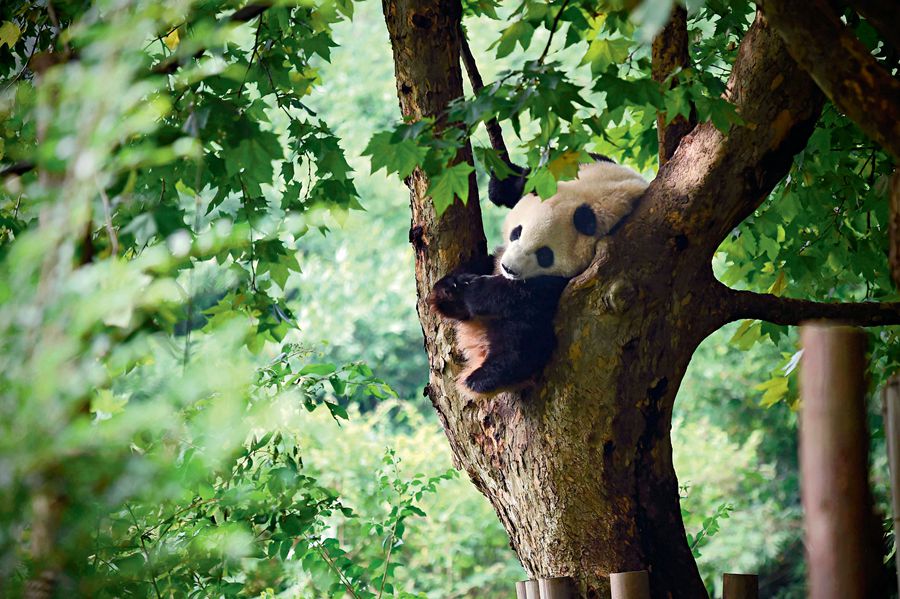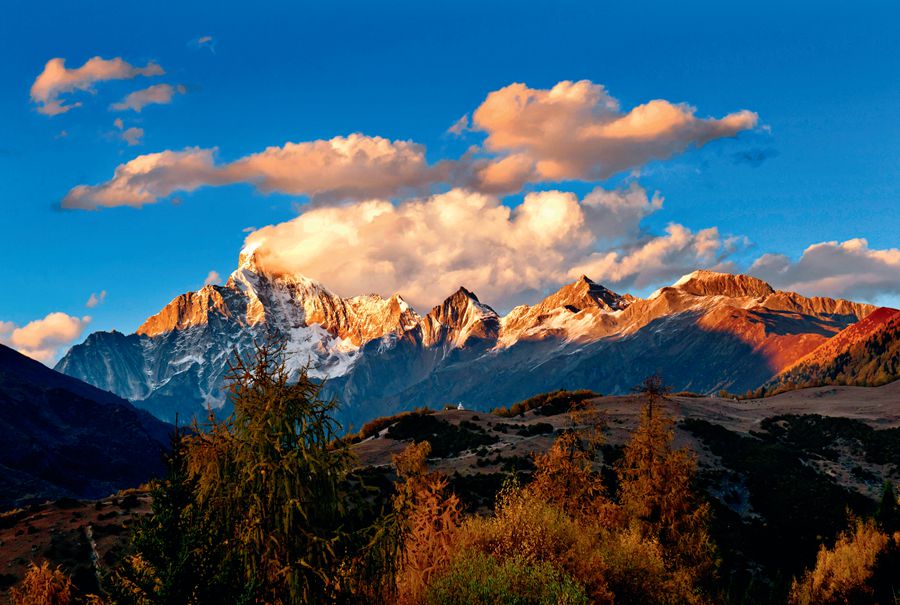THE Sichuan Giant Panda Sanctuaries cover a 9,245 square km area that includes the Sichuan Basin, Wolong Nature Reserve, the National Scenic Area of the Siguniang Mountain, and Jiajin Mountain. In the area are seven nature reserves and nine scenic areas in 12 prefectures of four cities, including Chengdu, Ngawa, Ya’an, and Garze. This region is the habitat of nearly all the 1,600 wild giant pandas in the world, as well as other endangered animals like the red panda, snow leopard, and clouded leopard. The natural environment here is similar to that of tertiary rain forests, and is one of the botanically richest regions outside tropical rain forests. It has been selected by Conservation International as one of 25 biodiversity hotspots in the world, and was identified by World Wildlife Fund (WWF) as one of the Global 200 ecoregions.
The Rise in Popularity of Giant Pandas
One third of the Sichuan Giant Panda Sanctuaries is located in Yong’an, Sichuan Province, and is home to nearly 300 giant pandas. It was for this reason that this city was honored with the title “Hometown of Pandas.”

The Chengdu Research Base of Giant Panda Breeding.
To better understand the story of how such a quiet animal as the panda became such an iconic figure of the animal world, we must go back in time to the mid-19th century. In 1869, a French Catholic missionary priest by the name of Armand David was serving at a catholic church that was built in 1839 in Dengchi Gully of Baoxing County. While there, he learned about the giant panda while hiking in a mountainous region of Yong’an (which today is called the Fengtongzhai National Nature Reserve). After his “finding,” he became the first person to introduce the giant panda to the Western world.
Today, there is a Giant Panda Cultural Publicity and Education Center located behind the Dengchi Gully Catholic Church in Baoxing County. This was the first research facility to combine feeding, breeding, and publicizing oIf giant panda culture.
The Fengtongzhai National Nature Reserve covers a large region of gullies, peaks, ravine streams, and lush vegetation. In addition to giant pandas, it is also home to more than 30 rare animal species such as the golden monkey and budorcas. Its unique topography and climate make it an ideal sanctuary for many rare species. Consequently, scientists have discovered and named 151 species of animals and plants from this region, making it an extremely rare natural biological gene pool.
In an effort to address the phenomenon of fragmentation of giant panda habitats, expand the gene pool of giant pandas, and create favorable conditions for releasing them back into the wild, the government began to build the giant panda ecological corridor in the 1990s, connecting the relatively isolated and individual giant panda sanctuaries by planting bamboo forests between them. As a result, this expanded the range of activity of giant pandas and increased communication between them. The Fengtongzhai National Nature Reserve is an important corridor area that helps promote genetic exchange and diversity of giant pandas.
Panda Conservation
Every year, millions of visitors travel from around the world to see the mysterious panda kingdom located in the region of Wenchuan County in Ngawa Tibetan-Qiang Autonomous Prefecture, otherwise known as the Sichuan Wolong Nature Reserve. One 10th of China’s wild giant pandas and half of all its captive pandas reside here.

A view of the Siguniang Mountains, also referred to as the “Eastern Alps,” which are located in Aba Tibetan and Qiang Autonomous Prefecture, Sichuan Province.
Established in 1963, it is the largest nature reserve in China, having a total area of 200,000 hectares. The main objective of the reserve is to protect giant pandas, other rare wild animal species and plants, and the alpine forest ecosystem. Surrounded by mountains and laced with flowing rivers, the elevation of the Wolong region ranges between 1200-6250 meters, making it a fertile haven for the growth of a spectrum of wild plants ranging from subtropical plants to plants found in alpine mountains. It presents a scene of serene natural beauty with its recently developed glaciers and fossil glaciers, virgin forests, bubbling springs, waterfalls, and alpine meadows covered with a carpet of exotic flora.
The nature reserve has completely protected a perfect habitat that meets the living and eating needs of giant pandas. The large area is filled with giant pandas’ staple food of bamboo, and provides relatively enclosed living conditions, all of which are completely customized to create a natural habitat of giant pandas in the wild.
To expand panda conservation, in 1983, the Wolong Nature Reserve cooperated with the WWF in setting up the China Conservation and Research Center for the Giant Panda. It has become the largest facility for giant panda scientific research and nature conservation in China, being made up of three bases in Wolong, Dujiangyan, and the Ya’an Bifeng Gorge. The China Conservation and Research Center for the Giant Panda has a total of six laboratories. It also has a few breeding houses and semi-free-range areas that are open to the public, in which visitors can observe the activities such as feeding and breeding of giant pandas.
On December 28, 2003, China finished building the Ya’an Bifeng Gorge Base. This base is the most modern and updated conservation and research facility in China with advanced technology and equipment. While visiting the observatory, visitors can learn about the giant panda research center, hospital, cub-rearing center, and breeding center. There are more than 300 wild giant pandas with over 70 captive giant pandas living in Ya’an alone.
Reintroducing Pandas Back into the Wild
Since July 8, 2003, the giant panda Xiangxiang, after finishing three years of “wilderness training” in preparation for being released back into the wild at the China Conservation and Research Center for the Giant Panda, was successfully released back into the wild. This marks a new stage of progress in China’s giant panda conservation work from rescuing them from the wild and doing artificial breeding in captivity to releasing them back into the wild. When Xiangxiang first showed aggressive behavior towards humans as a display of his territorial instinct, the caretakers said, “We would like to congratulate Xiangxiang on growing up. It is no longer a docile pet who comes at the beck and call of humans, but carries on the legend of a shared history of thousands of years.”
The Liziping National Nature Reserve is located in the Xiaoxiangling Mountain next to a village at an elevation of more than 2,000 meters, of which 90 percent of the residents are of the Yi ethnicity. The giant panda habitat area of 80,204 hectares is home to 30 wild giant pandas.
Since 2009, a total of nine giant pandas have successfully been returned back to the wild in Xiaoxiang-ling. Relevant follow-up and analysis work has also been carried out. A beautiful example of this success was the reintroduction of the giant panda Zhang-xiang. After two years of “wild training” for reintroduction into the wild, this giant panda returned back into the wild in Liziping National Nature Reserve in Shimian County, becoming the world’s first female giant panda to return to her free home in the wild. This also confirmed that the methods used to reintroduce the female that was born through artificial reproduction in captivity and then received relevant training for being reintroduced into the wild are successful. At the same time, it created a new record of an artificially reproduced giant panda who has survived five years after being released back into nature.
According to experts, the artificial reproduction of giant pandas and then reintroducing them back into the wild can supplement, rehabilitate, and realize the sustainable development of the wild giant panda population.
The Beauty of the Mountains Known as the “Eastern Alps”
The ecological zone of the Sichuan Giant Panda Sanctuaries is one of 200 major ecological zones in the world, and from looking closer at the eco-environment of the National Scenic Area of the Siguniang Mountains, we can better understand the mystery of this region.
The Siguniang (Four Sisters) Mountains are also called the Eastern Alps for their breathtaking scenery that is comparable with the Swiss Alps. The mountain range of four connected peaks displays a picture of rolling snow-covered mountains with grasslands, dense forests, and pastures. Not only can visitors find ideal places for mountain climbing, ice climbing, and exploration here, they can also observe the fossils of ancient fish and get a feel for the process of evolution of ancient creatures.
At the foot of the southernmost Daguniang (Eldest Sister) Peak there are many herders who raise yaks and horses. In the upper reaches of the mountain, forests and wild flowers can be seen everywhere. If visitors are lucky, they may find wild fungi as big as a bowl. Going higher in the mountain, the foliage suddenly opens up into a pristine alpine meadow. At 4,000 meters above sea level, the area is barren and the ground is covered with sharp rocks. The mountain peak is covered with snow throughout the year. During the months from October to April, the snow level can get up to the knees, while there is less snow during summer months.
Adjacent is the Erguniang (Second Sister) Peak. Every summer, rare animals scamper around the wild green trees and plants here. The mountain peak is dangerous and snow-covered the year round. The Sanguniang (Third Sister) Peak has beautiful scenery, complex landforms, and a rich variety of animal and plant species. The Yaomei (Youngest Sister) Peak is dotted with glaciers, beryl mines, forests and lakes.
According to local folklore, the four sisters turned into mountains on the fourth day of the fifth month on the lunar calendar. Today, every year on this day, people of all ages from the local Tibetan and Qiang groups all dress up in traditional attire, bring butter, barley wine, barley cake, and other food to offer a sacrifice on the natural altar of the Siguniang Mountains, Guozhuangping, and worship the mountain god.

